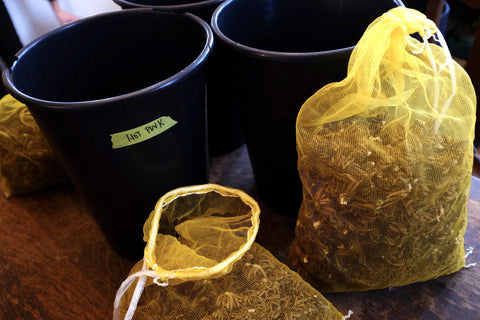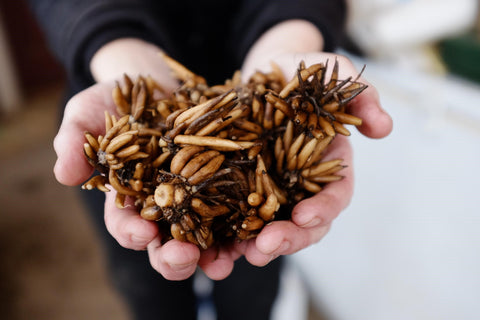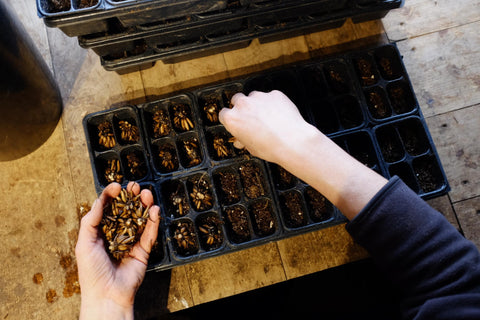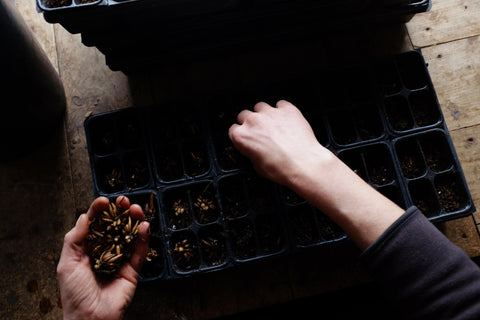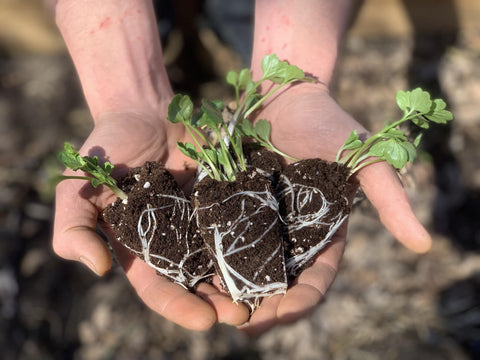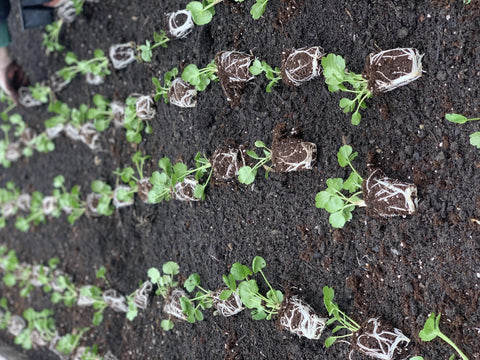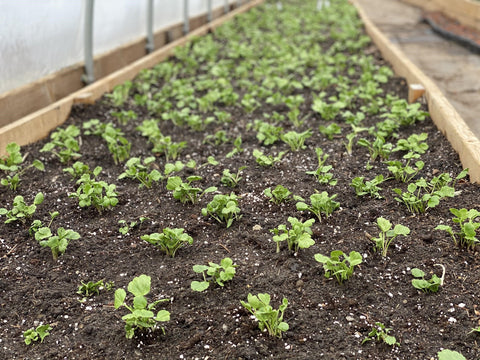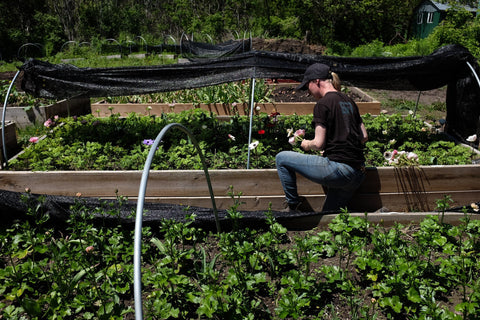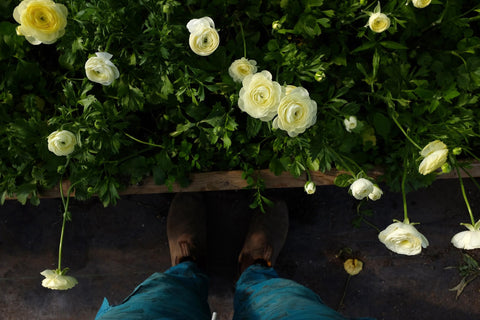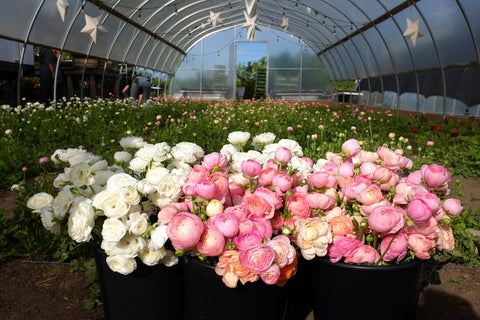It’s hard not to fall in love with Ranunculus —ruffled double blooms, an incredible range of colours, prolific flower production in the early spring, and wide range of colours reminiscent of sorbet —and these blooms are becoming increasingly coveted for home gardeners, who are looking to add something special to their spring lineup. With the desire to grow these beauties comes many questions. Are these corms difficult to grow? Do you plant in the spring or fall? Are these corms winter hardy?
With a little care, and some extra protection from cold temperatures, your own home gardens can be bursting with an abundance of the early spring beauty of Ranunculus and Anemones.
Follow along below, we’ll walk you through the entire sprouting and planting process!
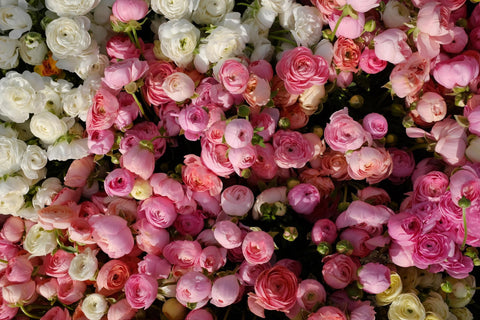
What to expect upon arrival of your corms:
Ranunculus and Anemone corms are stored and shipped in a dormant and dry state. The closest similarity they would have, would be to seeds. Similar to seeds, in the state they are in stored in (dry and dormant) corms can be shipped during the winter months without worrying about temperature. Many farms (including our own) ship corms out in the fall to excited gardeners, and again in January and February to those who may have missed ordering earlier. The best selection of varieties is often available for purchase from farms in the fall, when supply is at its peak.
Upon arrival, your corms can be stored for many months, as long as they are kept dry. If you receive your corms in the fall or winter, but are not planting them until the spring, they may be stored in the packages they are received in, and kept in a cool and dry place out of direct sunlight. Occasionally ‘legs’ may break off of the Ranunculus corms in transit. Don’t worry, your corms will still sprout!
When to plant:
If you are a gardener living in planting zone 8 or warmer you may sprout and plant your corms in the fall. If you live in planting zone 7 or cooler you must wait until the early spring to sprout and plant your corms.
Your first step: Pre-Germination
Pre-germination is an important part of the growing process of Ranunculus and Anemones, and we recommend that you don’t skip it. The best way to activate your corms to begin the pre-germination process is by soaking them. Soak your corms, in room temperature water, for a minimum of 4 hours.
During this time, your corms will swell to about twice their original size.
Your second step: Planting in trays
Once your corms have been soaked, they are ready to be planted in potting soil. Plant your corms in a high quality indoor potting mix, covering them lightly with potting mix once they are planted. Seedling trays work wonderfully for this part of the process.
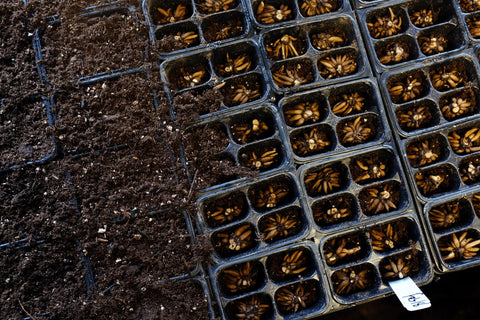
For Ranunculus, plant your corms with the ‘fingers’ pointing down.
For Anemones, plant your corms with the point facing down.
Your third step: Awaiting germination
Store your planted trays of corms for 2-3 weeks at 10C/55F in a cool and dark room, AWAY from a light source. It seems counter intuitive to place plants away from light, but in this case your corms to need darkness and cooler temperatures to sprout. A basement, cold cellar, or even a home closet will work well. Try to find the coolest (but above freezing!) space you have available to you, away from direct light. During this time, we are waiting for the corms to develop roots and sprout. During this time, your corms will swell to about twice their original size and develop little white rootlets that resemble hair. Avoid allowing your corms to dry out over these 2-3 weeks, but be sure not to over saturate the soil. Keep the soil consistently moist, your corms will need moisture to set roots, but they despise soggy feet.
Your fourth step: Bringing your plants to light
During the soaking and germination period your corms will develop little white rootlets that resemble hair. You will begin to see little nubs poking up through the soil, this is the crown of your plants beginning to awaken. When these little nubs of green (they may be white at first, due to a lack of light) begin to poke through —typically this takes 14-21 days —these corms can be moved into warmer temperatures and daylight and grown along into small plants. Place your plants in the brightest spot you have available now, whether that’s under a grow light, or just in a sunny South facing window. Remember, if your plants do NOT get enough light during this stage, they’ll grow leggy and spindly. Make sure they receive as much light as possible. You’ll want to grow these plants along to 2-3” tall before planting them outside.
Your fifth step: Planting outdoors
Once your small Ranunculus and Anemone plants are ready to plant outside, you’ll want to chose a location where your plants will receive 4-6 hours of sun each day. Your corms will love bright light in April and May, and May require a little more protection from the sun when the summer heat of June begins. You can provide a little June shade to encourage continuous blooming, either with a piece of shade cloth, or by planting your corms in large pots that can be moved out of direct sun when the June heat arrives.
Space your corms approximately 6” apart when planting them, to allow plenty of room for the plants to grow, with good air circulation.
You’ll want to plant your corms in healthy, well drained soil. You can plant in the garden, in raised beds or in large pots. We’ve tried each method here at the farm, and they all work well. We tend to have rocky soil here at our farm, with plenty of clay, so we typically plant our Ranunculus in raised garden beds, full of fresh triple mix, to give them the best start.
Once you’ve planted your corms outside, you’ll want to offer them protection on frosty nights, as they harden off and acclimate to the outdoor temperatures. This can be done by placing frost cloth (which can be bought online or through garden centers) over the plants, or placing plastic containers over the plants. Once your plants have hardened off for a couple of weeks, they’ll be able to handle the cooler evening temperatures.
Ranunculus are ‘cool season’ plants, meaning that they thrive in the spring, and begin to finish when the summer heat arrives. You can expect your ranunculus to bloom in May and June, and finish blooming when the summer heat of late June and early July arrives.
Timing: When to start and when you plant your corms
Our most frequently asked questions in this process all revolve around timing. When should you start your corms, and when should you plant them outdoors?
Growers in planting zones 8 and up will start this sprouting process in the fall, and plant their corms outside in October or November. Growers in cooler growing zones 7 and lower will plant their small plants outside in early spring. This can be done in planting zones 7 and lower 4 to 6 weeks before your last frost date.
We recommend counting 8 weeks back from your last frost date to find out when you should be starting your corms indoors.
At our farm, here in the rolling hills of Southern Ontario, our last frost is typically in mid May. Counting 8 weeks backwards means that we start our corms here in Mid March, planting them outdoors in mid April. Spring planted Ranunculus and Anemones can handle some light frost, but they do need to be hardened off before planting outdoors.
Winter Storage and Replanting
One of our most frequently asked questions is “Can I leave my corms on the ground over the winter, and will they come back?”
If you are a gardener in zones 7 or lower, unfortunately the answer is no. You will need to dig your corms up, and store them over the winter. Whether you did your corms up in the summer after they’ve finished blooming, or in the fall, the process is the same: dig your corms out of the garden, cut any live plants material off the top, allow your corms to dry out completely (this typically takes 24-48 hours), then place your corms in paper bags and store them in a cool and dry place over the winter. You’ll be able to start the entire process over again next spring!
If you’re a gardener living in zone 8 or warmer, you can simply leave your corms in the ground all year long. No need to dig them up and store them.
Ranunculus and Anemones do take a few special steps to grow, but they are always worth the effort. Their abundant spring blooms are such a breath of fresh air after a long winter, and they make exceptional cut flowers for enjoying indoors. Don't be afraid to get your hands dirty and try this process, you will be aptly rewarded with beautiful blooms!
How to Store
Ranunculus are shipped year-round in a dry, dormant state. If you are not ready to plant the dried corms, store them in this bag out of direct sunlight at room temperature for up to eight months. If you have lifted the corms from the ground, store tubers in dry moss, such as peat, in a mesh bag. Mesh onion bags are a great storing option for any bulb or tuber.















